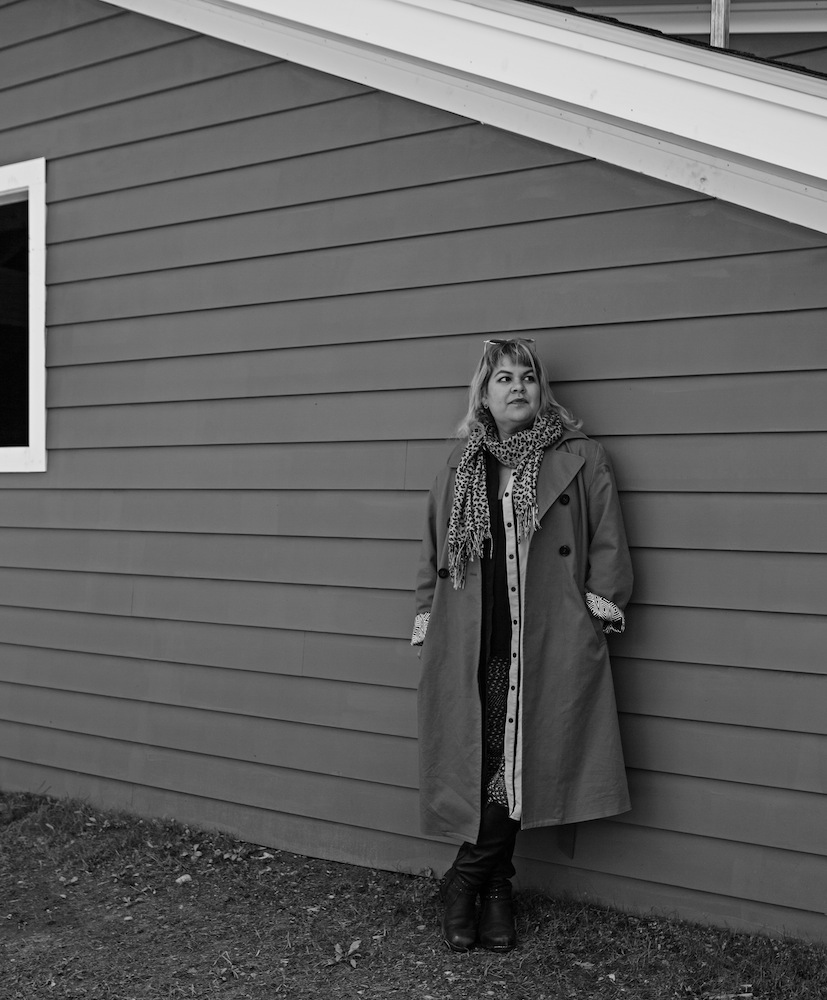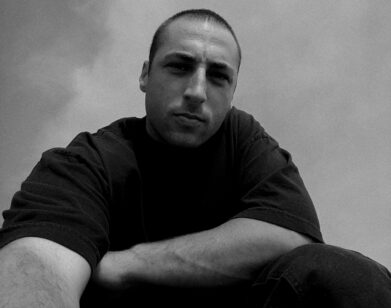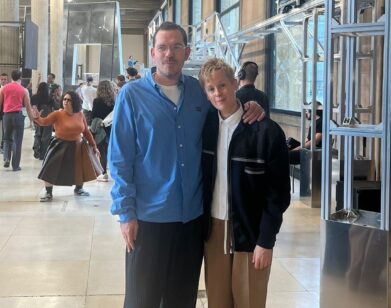From the Rooftops
HEATHER HART AT STORM KING IN NEW WINDSOR, NEW YORK, MAY 2017. PHOTOS: VICTORIA STEVENS.
“Who else should have a seat at the table?” This question is one artist Heather Hart poses to Storm King and its surrounding community. On the occasion of her one-season-long installation at the 500-acre sculpture park—the fifth iteration of their “Outlooks” series, which invites artists to create site-specific works—Hart built a crisp red attic with a tar rooftop in its hills. Titled The Oracle of Lacuna, it appears as though it’s emerging from or descending into the landscape, occupying an in-between space that’s representative of Hart’s approach. “I’m always aware that I’m an outsider in these spaces,” she says of her Oracles series, which consists of rooftops she’s built across North America, all of which engage with their respective locales. “I want to have more of collaboration where people understand where I’m coming from,” she continues. “I want the identity of the roof to change.”
The Oracle of Lacuna embodies a spirit of generosity, and opens up myriad dialogues. Visitors can climb atop it and view the Hudson Valley, or duck to enter its cool attic, which houses an oral history of the area that plays through speakers. Since the fall, Hart has recorded one-on-one conversations and roundtables with locals and academics on a variety of topics; other prompts include, “What comes to mind when you think of a rooftop?” and, “What have you been working on lately?” Additionally, a series of public programs including musical performances, a Habitat for Humanity workshop, and further roundtables are scheduled to take place before the piece comes to a close in November.
Interview recently spoke to the Brooklyn-based artist by phone.
HALEY WEISS: I’d like to talk about the series of rooftops you’ve been doing across North America and how that concept emerged.
HEATHER HART: I’m always obsessed with oral history, and I think that came from my family, growing up doing genealogy, growing up doing carpentry—carpentry I see as an oral history because it’s passed down from person to person. I was thinking about forms that represented that, something that’s passed down through generations, and also noticing that with oral histories there’s a slippage between what I hear and what somebody says—a changeability in that liminal space—and thinking about that middle space as a space that can shift with power, because people bring their frames of reference into any perception of communication. The rooftop was a metaphor for all of that in a way, because it’s literally, architecturally, between everything. It doesn’t normally sit on its own; it’s between the house and the exterior, and it’s a place that is between safety and the elements, between private and public. The form of the roof also refers to the house that I grew up in, helping my dad fix the roof, build an extension to our house, things like that when I was very young. I look for these liminal spaces in vernacular architecture.
WEISS: When you started the research for this project in the fall, where did you go first? What was your starting point?
HART: In general I was looking for myself, in a way. [laughs] I first started looking for people who had expertise in the history of African Americans and indigenous Native Americans in that location. My dad grew up in Massachusetts, and I feel like they’re very similar ecosystems and histories, so I was looking for people who might speak to that. Then I found out that the Underground Railroad ran through that Hudson Valley area, and, of course, the history of Sojourner Truth, and began looking for evidence of that and people who might know sites and specifics around that. So that’s where I started, with black history in the area. I searched for academics and asked librarians if they knew people or references I should be aware of. I love doing projects that require this echo of communication and depend on [community] to bring it to life or activate it in some way. I might cyber-stalk one person, or find someone in a book, or have a conversation, and then those lead to more people.
WEISS: When you were going through the history of the area, was there anything you learned that surprised you?
HART: One of the most poignant illustrations, which was a surprise, [came from] one of the librarians that I spoke to who did reenactments of the Hudson Valley historically before he was a librarian. He had a lot of expertise about the Underground Railroad, and told me that in fact, the rooftop was one of the places that they hid the escaped slaves in the Hudson Valley. It was maybe kismet, a coincidence, or maybe it was my ancestors talking to me, I don’t know. [laughs] But I thought that I was on the right track in form and space and whom I was talking to at that time.
WEISS: I wonder in what ways, if any, you see creating this archive as an intervention, insisting that this history is important and people should be aware of it?
HART: Absolutely. I do see the works that I do as a studio practice, and people say that painters are pretty isolated and narcissistic, and I don’t feel much different than that; I love finding things that I can grow with in my practice. But I also know that different groups of people talk about different things, and I find myself at an intersection in my own personal narrative—ways that I overlap with the white side of my family versus the black side of my family, and things that they talk about in common versus things that they don’t know about each other—and so this was a way for me find that intersection with all of these different communities, because there are so many within that five minute drive around Storm King. It’s a way to find, to unearth, what things people might not know, or might be surprising, or might be interesting, or something that people find in common. Basically, I want the piece to be able to stretch with different kinds of frames of reference, and so I love it when people are able to communicate and have a dialogue around that and then help each other. The more people discover about each other, the less there’s fear and judgment about the other.
WEISS: When you went into these roundtable conversations that you recorded, how did you arrive at the questions you asked? I know that one of them was, “What have you been working on lately?” which in its simplicity I think would be a really effective way of accessing what someone’s daily life is like in that area.
HART: I dabble in a little social theory, just because I am interested in this roundtable form and communication, and I want to have questions that are open-ended but might give people an opportunity to answer from different viewpoints. So for both the tables, there is a huge diversity, and the biggest thing was that table number two was all black stakeholders in the communities around Storm King. One of the things that I wanted to illustrate, which had been reemphasized to me during the process, was that blackness is not a monolith despite whatever the media is trying to push or whatever current events are happening right now. There’s such a variety, and we’ve been told that our narrative is one thing. I wanted to ask questions that were open-ended enough for people to bring what they actually are doing to the table. The black farmer [Karen Washington of Rise & Root Farm] is working on food justice, and relating what she’s doing to things that we’ve always done throughout history and had brought over from Africa, which people in the city may find very alien to blackness. I’m trying to create questions that might spur something interesting and unique in each person, and considering who is sitting at the table.
WEISS: You mentioned when we spoke the other day that the next roundtable you’re looking into is migration versus immigration, right?
HART: Yeah, or the two, maybe not even versus, but migration and immigration, those overlaps. In some of the conversations that I had people were very staunch in their ideas of one versus the other, but ended up talking about very similar things. We were talking about everything from old Irish immigration to the Hudson Valley, and then the ideas of gentrification in Newburgh, and really a lot of similar topics and concerns came up: the erasure of culture, the quickly changing economics. We ended up with both of those cases and many in-between, talking about the ethics of this kind of space and place movement.
WEISS: Related to that, when we first arrived at your installation, we were told that you wanted to be next to this Easter Island replica sculpture. I think that’s interesting conceptually to what you’re saying, so will you tell me what you thought would be at play between your rooftop and that sculpture?
HART: There are so many fractals I could talk about. In general, I was looking at these spaces of authorship and authenticity, so the idea of blackness in pop culture or media or history books is authored and truncated to fit a certain agenda, whether that be good or bad. But it’s very rarely unedited from the speaker’s mouth, and so that was one of the goals with the oral history archive. Then thinking about the Easter Island head, the idea of most of us knowing the reference of what that is, this Moai historical, protective figure, but it’s also is a fabrication. It’s like a third of the [actual] size, and it was created in the 1960s during this exotica culture, a movement that could be seen as cultural tourism and exploitation. Or is it maybe honoring something that we don’t have access to? This slippage between the narrative of history and authenticity and perception is the same thing happening in the Easter Island head. I thought it was interesting to be able to mill around and play, but then if you’re sitting on the roof long enough and notice that relationship, maybe after a few visits you can unpack that parallel. Then of course there are the literal things, like the rooftop looks like it’s going into the earth—the house might be underneath—and that’s the same with the Easter Island head; the figures, the bodies, were said to be underneath the earth.
WEISS: What has it been like spending time outside of the city? Has that changed your practice or affected your life on a day-to-day basis?
HART: I’ve always been someone who’s loved and grown up in nature, so it’s maybe given me a little revival of my tolerance of Brooklyn in a way. [laughs] Normally I’ll have to go away for a good three months, a chunk of time, each year. This year it’s been really easy to take a few day trips, or a week trip, and feel refreshed. I grew up with two hippie parents and two generations of artists before me, in a hippie elementary school, so we went camping for science class and learned how to build rooftops for math. It’s a familiar space for me, and in that way I feel like it was a really nice integration to my fall and spring.
“OUTLOOKS: HEATHER HART” IS ON VIEW AT STORM KING IN NEW WINDSOR, NEW YORK THROUGH NOVEMBER 12, 2017 WITH PUBLIC PROGRAMS TAKING PLACE THROUGHOUT ITS DURATION. FOR MORE ON HEATHER HART, VISIT HER WEBSITE.







